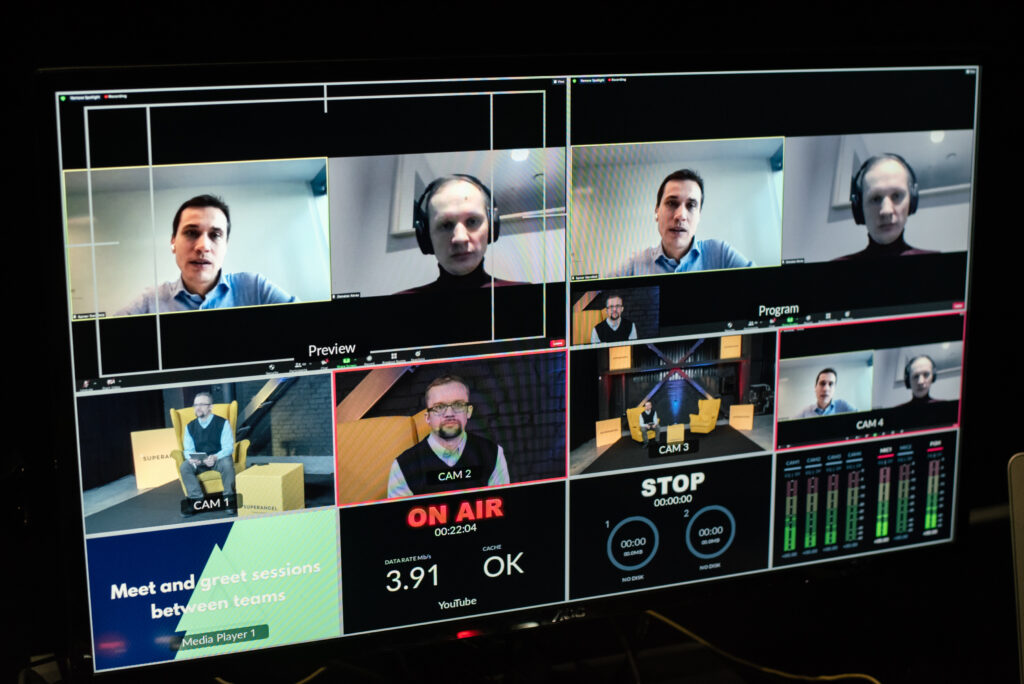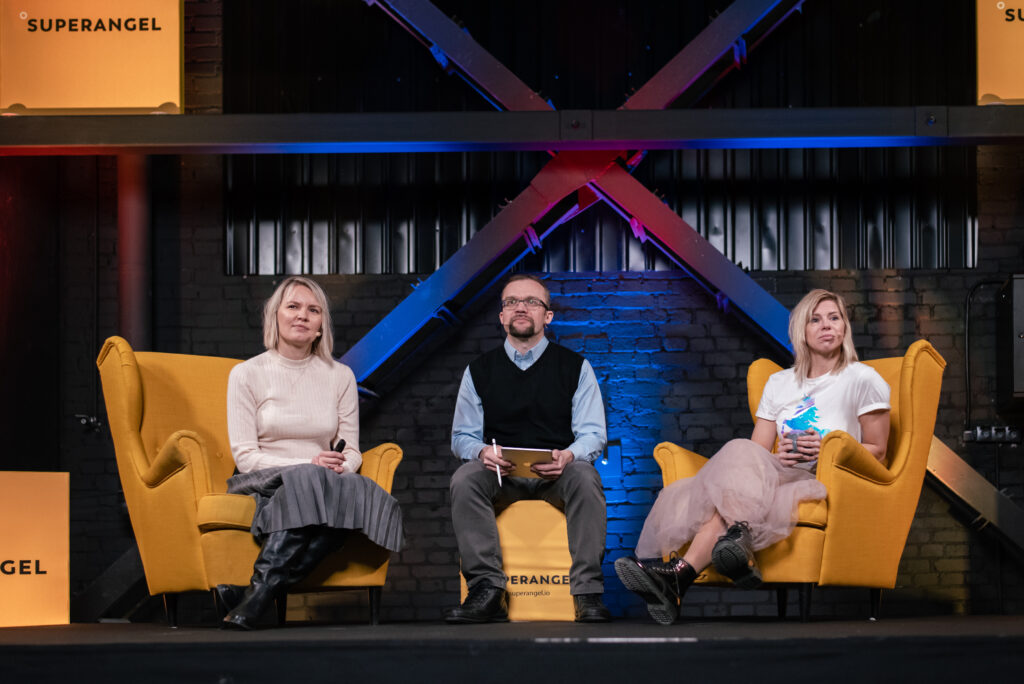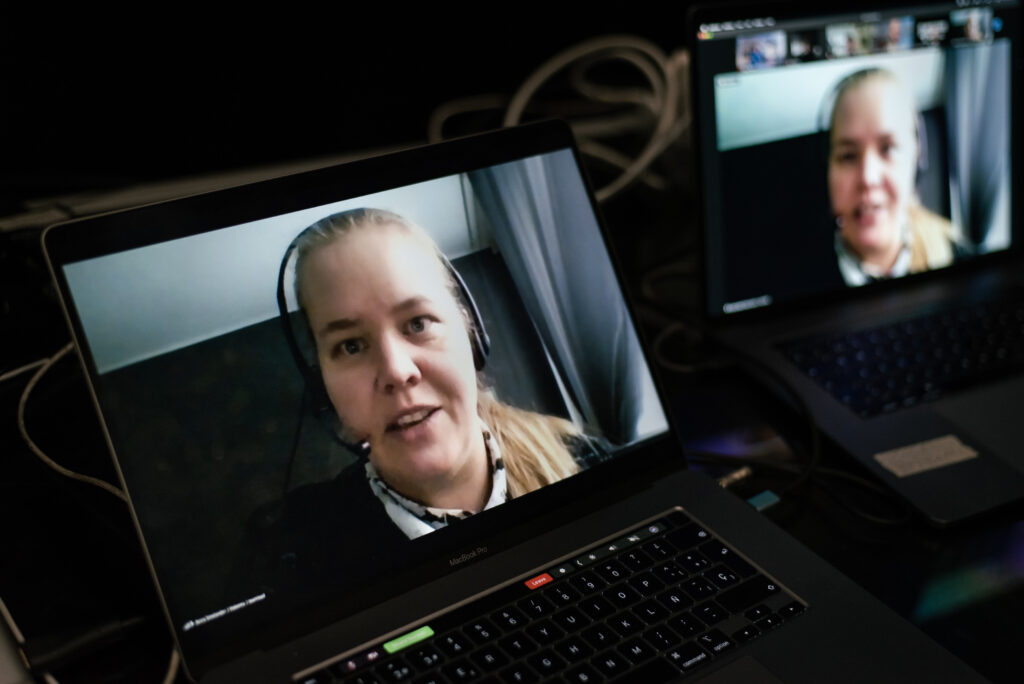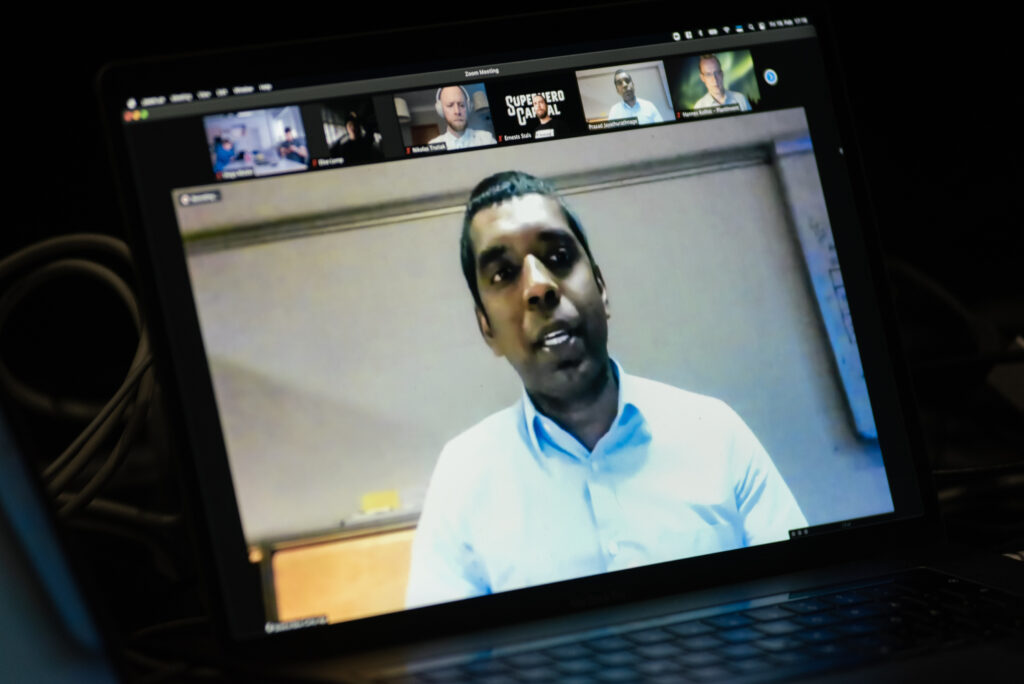We’re excited to host Meeri Rebane in the Superangel Insights session on ‘How to Skip Your Backyard and Launch in Big Markets’. Meeri is the CEO of INZMO, the #1 insurance startup to keep an eye on in 2021 according to Business Insider.
Find answers to questions like:
- How to enter major markets?
- Why did they as an Estonian startup choose Germany as their first market?
- How did they enter German market without speaking any German?
- How to find key employees in a new market?
“Startup founders have to think about the next fundraising every day. To do that, you need to think what kind of traction gets you there.”
Here are some key takeaways from the session:
- Entering a small market successfully might take more effort than entering a big one. And next round investors don’t care much about successes in small (home) markets
- The most important people in new markets are aggressive salespeople. Everything else you can do yourself
- Hire senior guys. They are motivated to work in a startup as they want to make their mark in the industry
- Launch a market where your valuable clients already are – it gives you credit and increases traction / interest.
- Big clients give you a big opportunity but it also takes a lot of time. It may mean your startup can die 3x during the period. Think – are you financially ready to survive long deals?
- Founders are like psychologists and providers who need to keep the employees motivated and help them do their job
- Find ways how to incentivise corporate partners so that they are willing to open up their client portfolio for you
Thanks Meeri for a great discussion! Best of luck achieving your 10M€ revenue goal for 2021!
5 universities, 11 ambitious science-based university teams, 7 VC firms, numerous experts, entrepreneurs and angel investors, 22h of mentoring and 3 workshops – the first Science Base Camp proved to be an incredible ecosystem effort across Nordics and Baltics.
Superangel joined forces with Aalto Startup Centre, University of Tartu, TalTech, Riga Technical University and University of Latvia to build a bridge between investors and future technologies, and help accelerate the commercialisation of science-based products. This is the first event of many, and we are looking to include more universities and VC partners to the initiative.
Here are the 11 forward-looking and innovative deeptech university teams from Science Base Camp you need to keep an eye on.
AIFORE – Aalto University & University of Helsinki, Team lead: Philipp Back
AIFORE is developing a scalable AI optimization tool for more sustainable and profitable forest management.
Currently, forest management is largely based on old and inflexible best-practice guidelines. Preliminary results show that AI optimization can increase the net present value (NPV) of forest assets by up to 20%, and the mean annual revenues by up to 14%. For large B2B clients, this translates into €5 – €15 million in additional timber sales revenues – per year. AIFORE also incorporates risk factors (e.g. forest forest, storms, insect, price fluctuations) to reduce the risk of forest investments by up to 20%. Lastly, AIFORE combats climate change by helping forest owners to find the best strategies for reducing CO2 emissions and preserving biodiversity.
The team has just received over 700k€ to explore the commercialization potential of their forestry research.
Cellboxlabs – University of Latvia, Team lead: Gatis Mozolevskis
Cellboxlabs is developing miniature human organ replicas called organs on chips to help pharmaceutical companies perform preclinical tests in human-like organs.
Drug development is expensive (1.54 bn) and currently ineffective (~10%). The key issue for gut related drugs is that there are no representative human microbiome research and test models at the preclinical research stage, which then leads to expensive failures in clinical trials. Organs on chip are microfluidic devices that in essence allow human cell culturing in small channels similar to human organ channel systems, therefore creating a more accurate test model of different organs for pharmaceutical companies and academic institutions alike.
They are preparing to raise a pre-seed round in 2021. They are aiming for 700k€ funding that would help drive early sales to research institutes and validate the product for entering the pharmaceutical market.
Drug Hunter Analyzer – TalTech, Team lead: Jekaterina Mazina-Šinkar
Drug Hunter Analyzer is a portable drug analyzer for onsite drug abuse determination in oral fluid.
Drug Hunter combines two powerful techniques in one box, namely capillary electrophoresis (CE) and deep UV fluorescence detection for illegal drug abuse determination in oral fluid. The only available roadside saliva drug tests based on immunoassay have high error rates and identify only illegal drug class, not drug itself or its quantity. Drug Hunter identifies and quantifies each illegal drug separately even in the multidrug abuse cases, providing reliable and accurate determination of recent drug use in minutes for onsite non-expert use.
They are looking to include funding in cooperation with larger public funds for commercialisation and large scale development projects.
EyeVi Technologies – TalTech, Team lead: Gaspar Anton
Enabling digitization data streams through the AI powered platform
3D data is becoming the next foundation layer in all geospatial content required applications. With their unique approach they are able to train their AI faster than any other competitor. EyeVi mission is to control daily updated 3D geospatial data streams for infrastructure digitization, automotive and digital twin sectors.To achieve that they’re offering a software and hardware solution for B2B clients that enables data capture and data production with their machine learning algorithms at market disrupting ROI and OPEX. Machine learning algorithms trained to generate specific features of road infrastructure using any input data (UAV, MMS, other sensors).
In 8 months, they have expanded to 5 markets. Now they’re raising a 1.2M€ pre-A round that adds to numerous public grants they have received so far.
HYMET – Team lead: Nikolas Trutiak
HyMet designs advanced thermal interface materials which are also powerful heat spreaders. This new class of material will make the next generation of electronics smaller, less power hungry, longer lasting and higher performing. HyMet materials have been benchmarked to reduce power consumption of electronics by more than 30% compared to stock materials and has been conducting 3rd party testing since Q3 2020.
Their materials have reached TRL5 and they are still accepting requests for proof of concept/pilot studies beginning in Q2 2021. With these results and market proven, HyMet anticipates being open for Seed Round investment in Q4 2021. To participate in a study or to request samples, visit their homepage.
HOKEMA – Aalto University, Team lead: Anna Smolander
A novel speech recognition that is able to give personal feedback for the speaker.
Hokema’s speech recognition is the first in the market using a solution that is able to recognise the exact mistakes speakers make in pronunciation. Therefore their speech recognition is more detailed and accurate than any else. While other speech recognizers quess what was said, Hokema’s solution knows it – at a very detailed level. And top of that it is able to give feedback for the speaker.
In addition to significant grants and Business Finland support, they’re looking to raise 200k€.
“Science Base Camp is the best start up event for University spin-off companies to attend: the organisers have an excellent understanding of tech commercialization and open innovation concept.” – Hokema
LASO-LIBS – Aalto University, Team lead: Antti Kotanen
Augmenting geologists with a superpower: Laser vision
LASO-LIBS stands for Large Area Scanning Operation Laser-Induced Breakdown Spectroscopy. It’s like traditional scanning LIBS but 1000 times faster. Analysis is based on machine learning models and neural networks. By scanning drill cores it can classify, identify and quantify elemental and mineral composition. This can result in 9% cost savings in an ore exploration project.
They’re looking to raise up to 320k€ to add to the grant funding they have already received.
NYMO – University of Tartu & TalTech, Team lead: Heigo Põld
An autonomous robot ship
The multi-purpose autonomous robotic vessel is able to perceive the surrounding environment and navigate the given mission points without external interference. The robot ship recognizes various objects at sea and is able to make the necessary decisions. This developed robotic ship is both an innovative product and a service delivery platform that can perform different tasks as well parcel and cargo transportation services.
They’re looking to raise 3,5M€ in addition to the grant funding received so far.
Parkzia – Aalto University, Team lead: Prasad Jayathurathnage
Disruptive solution for trouble-free contactless charging for autonomous E-vehicles and robots.
The team has created a unique technology to enable very high-efficient wireless charging solution with full positioning freedom. The patent pending technology has been proven using a proof-of-concept prototype. Machine learning assisted algorithms are implemented to control the charging and enabling safety.
They’re looking to raise around 1M€ in addition to significant grant funding.
“We really got important feedback how to improve our investor readiness. Now we have a clear plan for next 8 weeks.” – Parkzia
PlantInvent – University of Tartu, Team lead: Hannes Kollist
Providing whole plant gas exchange analysis
Today, most gas-exchange measurements are carried out in single leaves and guard cell signaling is often measured in epidermal peels. PlantInvent aims to bridge the gap to a more comprehensive understanding of plant physiology by providing whole plant gas exchange analysis. They do so by using their custom-built gas exchange devices for Arabidopsis thaliana as well as for other species.
They are looking for funding worth 300k€.
TWinTech – TalTech, Team lead: Vladimir Kuts, Ph.D.
Universal SaaS software for simulation, programming, and real-time control of manufacturing units and robotic systems.
Their solution is able to control and simulate any aspect of the production line without limitation by brand or type of the machine, as well as being managed and self-learning independently by the exploitation of Machine Learning algorithms. The toolkit is being developed by using a game engine (Unity3D) enabled with machine learning, virtual/augmented reality, and various telemetry/interface technological solutions (ROS, MQTT).
They’re looking to raise 220k€.
Curious to know what was discussed at the event? You can find out – the workshops of Science Base Camp can be rewatched.
What are investors expecting from science-based teams
How to build a list of 100 key people
Action plan on increasing investment readiness
Interviews with VCs at the event
That was a blast! See you at the next Science Base Camp!
Overview
By Q3 Estonian startups had already withstood a quarter of the economic challenges resulting from COVID-19. While Q2 showed signs of struggle, Q3 was representative of a more optimistic outlook with promising signs of economic recovery. Q3 also witnessed Estonian startups and the ecosystem as a whole beginning to pivot from the revenue decline of Q2 and towards the high growth trajectory of pre-COVID times. Based on publicly available data in Superangel 500 we looked for answers to the following questions:
- What did the startup environment in Estonia look like in Q3 2020?
- Which companies had the biggest rebound since Q2?
- How did Bolt fare in Q3 in comparison to Q2?
- How does Estonia’s startup ecosystem in Q3 fare in comparison to the rest of Europe?
- What have we learned from the pandemic thus far?
Quick Highlights
Startups with the highest growth in revenue from Q2 to Q3 were:
Estonian startups with the highest % increase in revenue in Q3 2020 were:
- Precision Navigation Systems
- Nordic Automation Systems
- Remotely
- New Digital
- Powerful Fuel Cells
- Transformative AI
Revenue amongst Estonian startups in Q3 2020 was 255M€.
The total amount of tax paid by Estonian startups in Q3 was 33.5M€.
The number of people employed in Estonian startups in Q3 was 7,574.
What Does The Startup Environment in Estonia Look Like In Q3 2020?
Estonia’s startup ecosystem in Q3 showed signs of recovery, while Q2 showed signs of slight economic decline. Q3 was more representative of pre-pandemic times. The total revenue was 256M€. The total paid in taxes was 34M€. The total number of people employed in Estonian startups in Q3 was 7,574. Q1 2020 saw some of the highest KPI values in the Estonian startup ecosystem. It is important to see how Q2 and Q3 differed in comparison to Q1. In terms of revenue, Q3’s revenue decreased 9M€ since Q1, but increased 30M€ since Q2. In contrast, Q2’s revenue decreased 39M€ from Q1. In terms of revenue, Q3 outperformed Q2.
Additionally, in Q3 the total number of startups with an increase in revenue between Q1 and Q3 was 239, while the number of startups with a decrease in revenue between the same quarters was 298. Furthermore, 296 Estonian startups saw an increase in revenue between Q2 and Q3, while 271 saw a decrease in revenue in the same quarters. Startups with the highest revenue in Q3 2020 were:
15 out of 20 Startups with Highest % Increase in Revenue were Early-Stage Companies
Q3’s startups and their revenue can be broken up into three quarterly revenue groups: light-weights, medium-weights, and heavy-weights. Light-weights are startups that had a quarterly revenue of less than 100,000 €. Medium-weights are startups that had a quarterly revenue ranging from 100,000 – 1,000,000 €, and heavy-weights are startups that had a quarterly revenue of more than 1,000,000 €. The total number of light-weight startups in Q3 was approximately 443. The total number of medium-weight startups was 136, and the total number of heavy-weight startups was 37. This grouping can also be applied to the 20 startups that saw the highest percentage increase in revenue between Q2 and Q3.
Of the top 20 startups with the highest % increase in revenue between Q2 and Q3, 18 of them were light-weights, 1 was a medium-weight, and 1 was a heavy-weight. Similarly amongst the top 20 companies with the highest % increase in revenue between Q1 and Q3, 15 startups were light-weight, 3 were medium-weight, and 2 were heavy-weight. This is indicative that startups that were in their initial phase, and/or startups that are focusing on more regional small-scale efforts, were growing faster and performing well despite the pandemic.
Between Q2 and Q3, the top 3 light-weight startups with the highest % increase in revenue were:
The top 3 medium-weight startups with the highest % increase in revenue were:
The top 3 heavy-weight startups with the highest % increase in revenue were:
Taxes and Employment
Taxes in Q3 also showed signs of recovery. The total amount paid in taxes by Estonian startups in Q3 was 33.5M€ which was higher than the 28.6M€ paid in Q2. The 20 Estonian startups that paid the most in taxes were:
The 15 startups that paid the most in taxes in Q3 contributed approximately 58% in total Estonian startup taxes.
In regards to employment, Q3 saw an uptake in the number of people employed in Estonian startups. In Q1 there were a total of 7,700 people employed in Estonian startups, in Q2 there were 7,400 employed, and in Q3 there were 7,574 employed.
The top 20 companies with the most employees in Q3 were:
The slight difference between Q1 and Q3 employment levels, alongside the upward trend of employment between Q2 and Q3, is another indicator of the beginning of economic recovery. However, Q3 2020’s employment numbers were not as strong as Q1 2020 which indicates that there is still room for more growth and recovery.
Which Companies Had The Biggest Rebound Since Q2?
Aside from Bolt’s rebound, many other startups showed strong signs of recovery and rebounding. To determine which startups were able to rebound we looked at two different rates of change. We first calculated the companies which had the largest percentage decline in revenue between Q1 and Q2. From the resulting list, we were able to see which companies had the largest growth rate in terms of revenue from Q2 to Q3. These companies’ upward trajectory from Q2 was indicative of which startups were able to rebound in Q3. The 20 startups that had the largest percentage decline in revenue between Q1 and Q2, but the largest percentage increase in revenue between Q2 and Q3 were:
We used this form of analysis to determine the top startups based on Q3 revenue in each category of light-weight, medium-weight, and heavy-weight startups.
A shift from a focus on Unicorns to Camels
However, based on the work of the Harvard Business Review, one of the most critical lessons from Q3 was to look for Camels instead of Unicorns. Camels are companies that can survive in long adverse conditions and shaky startup ecosystems. Camels can implement strategies that are balanced in growth, resilient and diverse. These types of startups have a higher probability of surviving market shocks and challenging times. Ultimately with the negative impacts of Covid-19 on the Estonian startup ecosystem, as well as the global startup ecosystem, it seems that a shift from a focus on Unicorns to Camels is necessary. While Estonia might be chasing new and up-and-coming unicorns, Q2 and Q3 show that maybe a new strategy, or an updated one, is needed for prolonged sustainability.
We can interpret that Camels are startups whose revenue growth from Q1-Q3 had been steady or dropped the least. Additionally, they continued to grow at a consistent rate despite a possible hiccup in Q2. These are startups that potentially lost the least in sales. We were able to find some of these camels by looking at companies whose change in revenue fluctuated by +/- 5% between Q1 and Q2. From that resulting list, we determined the companies whose change in revenue ranged from more than 0 to less than or equal to 5% between Q2 and Q3. These can be considered Camels because overall they had steady revenue streams despite the pandemic. The companies that resulted from this technique were:
Here we see two light-weight, one medium-weight, and one heavy-weight camel. This displays that in environments like that similar to Q3, it is possible for any size startup to have growth modeling that of a Camel startup. As a result, startups of different sizes have the possibility of surviving adverse conditions in the startup ecosystem.How Did Bolt Technology Fare in Q3?
Estonia’s Unicorn, Bolt, lost the largest amount of money between Q1 and Q2 in comparison to the rest of the Estonian startups. In Q2 Bolt lost 37M€, a drop of 44%. During Q2 Bolt had a large impact on the overall outlook of the Estonian startup ecosystem. If we kept Bolt’s revenue in Q2 consistent with that of Q1, the revenue of Q2 would have been 263M€ instead of 226M€. Luckily, Q3 saw a much more positive outlook for Bolt. In Q3 2020, Bolt had a total revenue of 81M€ which was a significant increase from Q2, and a value close to that of Q1’s.
This shows the resilience of Bolt. While Bolt has more issues to tackle, they were able to address the issues that were posed during Q2. During Q3 Bolt was able to adapt to new circumstances by implementing further safety measures, setting their eyes on e-scooters, and further expanding into the food delivery market. Bolt’s steps to recovery were consistent with that of the entire Estonian startup ecosystem’s recovery.
How Does Estonia’s Q3 Startup Ecosystem Fare In Comparison To The Rest Of Europe?
Both the EU and Estonia showed signs of recovery during Q3. However, the speed and sustainability of the recovery differed amongst both groups. The sustainability of the recovery seems more plausible for Estonia than that of the rest of the EU. This issue was discussed in our Q2 2020 post as well. To summarize, the reason for much of Europe’s startup ecosystems decline was due to much deeper rooted issues than that of Estonia. The rest of Europe saw a declining trajectory for their startup ecosystem much sooner than Estonia did. Additionally, with issues such as Brexit, the overall improvement of ecosystem metrics in the entire EU is not as promising as that of Estonia’s.
Regardless, both groups showed many similarities and signs of resilience. Overall the EU’s ecosystem saw sectors such as Biotech, Edtech, Health, and Fintech to be those with the highest growth and promise. The EU saw increased growth in software startups and health startups which was no surprise given the conditions that arose from COVID-19. Similarly in Estonia, the country saw growth in and promise in sectors like Business and HR Software, Fintech, and AdTech and Creative Tech. The prominence of the software startups in both groups is important because it is indicative that both groups were able to adapt and take advantage of the shift towards remote work, school, and e-commerce. Both groups also saw many funding deals continue to take place. Estonian startups signed 55 funding deals in the first nine months of the year. Similarly, European funding in Q3 saw its strongest funding since Q3 2019. The comparison between both parties gives insight into various recovery strategies and patterns during an unprecedented time and allows everyone to learn from each other, especially during times of recovery.
What Have We Learned From The Pandemic?
COVID-19 has served as a great learning experience for Estonia and other countries and their startup ecosystems. These ecosystems have learned how to become adaptable, flexible, and resilient during unprecedented times. Most importantly, crises can offer opportunities for existing startups to flourish, and new startups to emerge. Research has shown that many successful and innovative startups like Uber, Airbnb, and WhatsApp started during or right after the global financial crisis. During the SARS outbreak in China, Alibaba’s Taobao was founded. Hopefully, startups during this time have learned the importance of adapting to market demands, identifying and analyzing opportunities before it is visible to everyone else, and staying persistent in regards to securing funding. Overall, we were able to learn that in Q3 the Estonian startup ecosystem was able to adapt and begin to grow despite unprecedented circumstances.
The series of these articles have been written through an objective lens by Harshita Bhatt, who joined Superangel team through the 101 Fellowship.
Disclaimer: The numbers reported may differ from the data reported by Startup Estonia due to some differences in selection criteria.
If you want to make your own rankings and lists, then go and play with numbers on Superangel’s Estonian startup statistics page: startuplist.superangel.io
Overview
On February 27th, 2020, Estonia marked its first case of COVID-19, and by March 12th the country went into lockdown. These moments marked a turning point in the country’s startup economy. It was here where Estonia had to face the challenges that came with a global pandemic. While Q1 of 2020 showed signs of high growth and revenue, Q2 told a story of slight economic decline resulting from the pandemic. Q1 also failed to reflect the true impact of the COVID-19 pandemic. However, even in these trying times, there are significant and encouraging signs of optimism. Based on publicly available Q1 and Q2 data in Superangel 500 we looked for answers to the following questions:
- What did the startup environment in Estonia look like in Q2 2020?
- What were the pain points during COVID-19 Q2?
- Which companies were able to find some semblance of success during COVID-19?
- What were the differences between Q2 2019 and Q2 2020?
- How did Estonia’s startup ecosystem in Q2 fare in comparison to the rest of Europe?
- What signs indicate optimism for the future?
Quick Highlights
Startups in 2020 with the highest growth in revenue between Q1 and Q2 were:
1. Digitouch
2. First International Play Money Exchange
3. Vetik
4. BHC Laboratory
5. Nutriloop
6. Netnigma
7. Canese
Estonian Startups with the overall highest revenue in Q2 2020 were:
1. Bolt
2. Fortumo
3. Pipedrive
4. Adcash
5. Creative Mobile
6. Synctutition
7. Toggl
Revenue amongst Estonian startups in Q2 2020 dropped by 38.9M€
Total taxes paid were 28.6M€
The total number of people employed in an Estonian startup in Q2 2020 was about 7,400
What Did The Startup Environment In Estonia Look Like In Q2 of 2020?
Q2 2020 in Estonia’s startup ecosystem can be characterized by the pause of high levels of growth. Before COVID-19 many believed that Q2 2020 would have a strong showing given the strength and trajectory of the past years and quarters. Unfortunately, Q2 put a damper on the widespread optimism regarding Estonia’s startup ecosystem. The total revenue in Q2 was 226M€. This value marks the halt of an era that was characterized by high revenue growth seen from Q4 2017 till Q1 2020.
The graph below shows the companies with the highest revenue in Q2.
Notably, in Q2 we saw 296 companies with an increase in revenue, while 271 saw a decrease in revenue. This isn’t uncharacteristic given that many companies were facing the damage that came with COVID-19 and the subsequent economic lockdown.
Taxes also offered an interesting insight into Q2 and the startup ecosystem in Estonia. In Q2 2020, the total tax paid by Estonian startups was approximately 28.5M€. This is in contrast to that of Q1 which saw that the total paid in taxes was 30.7M€. The 20 startups that paid the most in taxes are shown in the graph below.
The 15 startups that paid the most in taxes in Q2 contributed towards 58% of overall taxes paid by Estonian startups.
The 15 startups that paid the most in taxes in Q1 contributed towards 54% of overall taxes paid by Estonian startups.
Q2 also saw new players entering the top 15 of the largest tax contributors. These companies were Onoffapp, Scoro Software, and Fortumo. In contrast, Milrem, Monese, and Fiizy left the top 15 list in Q2.
Employment statistics also provided information regarding Estonia’s startup ecosystem in Q2. The total number of employees in Q2 was approximately 7,400. The companies that had the most employees are visible in the graph below.
It is praiseworthy that companies were still able to hire new staff during challenging and historic times. There are potential reasons that some companies were still able to hire employees or retain their current employees. One of these reasons was the Estonian government’s response to COVID-19 and employment. The Estonian government took temporary measures to prevent unemployment and help struggling businesses. The Estonian Unemployment Insurance Fund declared that it would cover 70% of employees’ original wages to Estonian businesses that were struggling. The payment would go through if certain criteria were met such as:
1. The employer had suffered at least a 30% decline in turnover or revenue for the month they wish to be subsidized for as compared to the same month last year
2. The employer is not able to provide at least 30% of their employees with work
3. The employer has cut the wages of at least 30% of employees by at least 30% or down to the minimum wage.
Additionally, the government proposed additions to the budget that allowed business loans earmarked for liquidity to support companies. These government policies helped reduce the drop in employment and helped companies stay afloat. While overall indicators like revenue, taxes, and employment decreased since Q2, we were still able to see companies doing well and standing strong during the economic toll of COVID-19.
What Were The Pain Points During Q2 Amidst Covid-19?
Bolt. The significant impact Bolt had on Q2 numbers should not and cannot be ignored. Bolt is Europe’s ridesharing startup offering fierce competition to Lyft and Uber. While Bolt is Estonia’s Unicorn and generates more revenue than other Estonian startups, it greatly struggled in Q2. A large reason for its struggle was because of the nature of the business. European lockdowns due to COVID-19 reduced the number of people utilizing ridesharing apps. Additionally, Bolt was not well set up for large economic challenges. The startup has never made a profit and relies heavily on venture capital investments and European Investment Bank loans. Additionally, during the early months of the pandemic, the company requested a loan of 50 million € and became part of the government’s job retention scheme to stay afloat. Q2 statistics for Bolt did not look promising. Europe’s ride-sharing startup lost the largest amount of money between Q1 and Q2 in comparison to the other Estonian startups. Bolt lost 37M€, a drop of 44%.
Additionally, the total amount paid in taxes also decreased. It is difficult to determine the future trajectory of Bolt even after Q3 and Q4 data is analyzed. On one hand, similar players in the industry like Uber and Lyft have announced large layoffs due to COVID-19. Furthermore, with the potential of more lockdowns, it might be a while before the number of people ride-sharing resembles those of pre-pandemic. On the other hand, Bolt has many investors and the Estonian government on its side. Additionally, it occupies a large chunk of the industry space. Other sources of potential rebounding are derived from Bolt’s new partnership with Google Maps, their global expansion, and their venture into the food delivery space. The food delivery space is a large part of daily life when dine-in services aren’t available during COVID-19.
The best way to summarize Bolt’s impact on Estonia’s startup ecosystem in Q3 is to look at Bolt’s drop in revenue in conjunction with the the other startups and their losses. Bolt had a very large impact on the overall outlook of the Estonian startup ecosystem. Bolt contributed largely to the aggregate revenue loss amongst startups in Q2. If we kept Bolt’s revenue in Q2 consistent with that of its Q1 revenue (85M€), the overall revenue of Q2 would have been approximately 263M€, which would have made the drop in revenue 1.7M€ instead of 38.8M€.
Which Companies Were Able To Find Some Semblance Of Success During COVID-19?
There are several ways to determine the winners of Q2. Speaking solely from the perspective of companies with the highest growth in revenue, some of the top companies were Digiotouch, First International Play Money Exchange, Vetik, BHC Laboratory, Staycool, Threod Systems, and Bitofproperty. These companies continued to largely increase their sales despite the pandemic. Thus, these companies are some of the winners of Q2.
Given the vast differences amongst Estonian startups, especially regarding revenue, the 20 startups with the highest percentage increase in revenue in Q2 can be divided into categories based on their Q2 revenue. These categories can divide into light-weights, medium-weights, and heavy-weights. Startups with a quarterly revenue of less than 100,000 € are considered light-weights. Companies with a quarterly revenue of 100,000 – 1,000,000 € are medium-weights, and heavy-weights are companies that have a quarterly revenue of more than 1M€.
There were many light-weights that were in TOP20 regarding change in revenue. The top 3 light-weights with the highest percentage increase in revenue were:
The medium-weights in TOP20 with the significant percentage increase in revenue were BHC Laboratory (+5091%) and Cleanhand (+967%).
The heavy-weights in TOP20 with the largest percentage increase in revenue were Staycool (+1189%) and Threod Systems (+1107%).
In Q2 2020 out of the 20 fastest growing Estonian startups, 16 startups were lightweight, 2 were medium-weight, and 2 were heavy-weights. This is indicative that startups that were in their initial phase, and or startups that were focusing on more regional small-scale efforts, were growing faster and performing well despite the pandemic.
Startups founded in 2020 should also be considered winners. Another indicator of companies who were able to survive the pandemic are those who hired new employees during a rise of unemployment in Estonia. The companies that have managed to hire the most people in Q2 were Goworkabit Estonia, Skype Technologies, H2H, Modular, Mindtitan, Comodule, and Synctuition.
What Are The Differences Between Q2 2019 And Q2 2020?
Comparing Q2 2019 and Q2 2020 showed that the impact of COVID-19 on the Estonian startup ecosystem was not as drastic as some might have imagined. Q2 2020 had approximately 65 more startups than the prior year. The revenue in Q2 2020 was 225.9M €, while the revenue in Q2 2019 was 209.6M€. Regarding taxes, Q2 2020 saw approximately 28.6M€ in contrast to 25.6M€ in Q2 2019. Team sizes also differed amongst the two quarters. We saw the total number of people employed in a startup go from 6,692 to 7,400. As seen above, we can also divide the startups in these quarters up by revenue.
We divided these startups into 3 quarterly revenue groups: below 100,000 € (light-weight), 100,000 – 1,000,000 € (medium-weight), and 1,000,000 and up (heavy-weight). In Q2 2020 there were 406 light-weight startups (+68 YoY), 140 medium-weight startups (+13 YoY), and 35 heavy-weight startups (+7 YoY).
The improvement in key performance metrics from Q2 2019 to Q2 2020 shows that the hit the Estonian startup ecosystem faced was not significant. The success of the ecosystem is best seen in its ability to not fall below Q2 2019 numbers.
How Does Estonia’s Startup Ecosystem In Q2 Fare In Comparison To The Rest Of Europe?
The impact of COVID-19 on the startup ecosystem of Estonia versus the rest of Europe was significantly different. Europe in Q1 2020 was hopeful that Q2 2020 would yield more positive results than Q4 of 2019 and Q1 of 2020. Many investors also believed that the lower numbers of Q4 were due to seasonal fluctuations often seen in Q4 of various years. However, that seemed unlikely to be the case. In 2019, Europe saw their startup economy beginning to lose traction, while Estonian startups saw record revenues and trajectory growth. The difference between when the two groups began to see a decline in their startup ecosystem is incredibly telling. The case of Europe shows that the economic decline amongst their startups is symptomatic of problems larger than COVID-19. In contrast, Estonia’s decline in revenue and other key performance indicators are only seen in the scope of Q2 of 2020, meaning that the pivot from record-breaking growth is most likely not due to a larger underlying issue, but a product of COVID-19.
What Signs Indicate Optimism For The Future?
There were several factors that provided optimism to those invested in the Estonian startup ecosystem. As seen above it can be noted that Bolt contributed to a significant portion of the downfall in total revenue between Q1 and Q2. Some other positive notes about Q2 were that the overall salary in an Estonian startup in Q2 was still higher than that of the overall Estonian average income in Q2. Additionally, big investments were still made in the first half of 2020. Some of these include Bolt, Veriff, Pactum, and Milrem Robotics. Companies were still starting in the first half of 2020, as well as various acquisitions. Between Q2 of 2019 and Q2 of 2020 more than 60 startups were founded. The Estonian Startup Visa still has 317 temporary residency permits and visas to work for Estonian startups. Several of these permits were given to startup founders. These positive signs are part of a much larger pattern in Estonia. The Estonian government implemented certain policy initiatives making their startup ecosystem stable, with room for innovation. The core initiatives that have helped maintain the startup ecosystem were the country’s tax policies, the country’s digital capabilities, and Estonia’s e-Residency program. Overall, Estonia’s startup ecosystem managed to sustain itself in Q2 and position itself for a brighter Q3 and beyond.
The series of these articles have been written through an objective lens by Harshita Bhatt, who joined Superangel team through the 101 Fellowship.
Disclaimer: The numbers reported may differ from the data reported by Startup Estonia due to some differences in selection criteria.
If you want to make your own rankings and lists, then go and play with numbers on Superangel’s Estonian startup statistics page: startuplist.superangel.io
You’re an early stage startup. You don’t yet have thousands of euros revenue flowing into the company every month. So, how to make the most out of marketing with a limited budget and get your feet off the ground? And how can you use marketing to lift up your sales team? Here are insights from Annika Ljaš, a Visiting CMO in a Superangel webinar.
Being a founder with no marketing expertise, it must be difficult to figure out which trend you should be currently following. Is it content creation and blogging? Google ads? PR? And what are the channels you should be using? OK. Let’s take a step back and start from the things that work and are at your disposal already today.
Interested in the topic? Check out also our growth hacking post on how to increase revenue without increasing ad spend with Kristel Tuul.
How to avoid mindless marketing?
One thing is for sure. You shouldn’t base your marketing strategy on trends and advice that does not match your goals. You’ll always be feeling like ‘Oh, I’m not doing that’. Be critical to what is actually working and what is simply a buzz from marketing people looking to sell you their services.
To be able to implement the right advice at the right time, you need to understand what is happening around you. What are your competitors doing online? Where do your clients spend time? Invest your time into online research and accomplish the following:
- Know your market and follow your competitors/companies similar to you. Track what they’re doing online by researching their activity within the last year, month, 24h. You’ll find out what could also work for you.
- Know your clients. Spend time where your clients do. Follow the newsletters they’re interested in. Track keyword trending on Tweetdeck to get up to date with the latest industry terms.
- Talk with your sales reps.
- Repeat everything that has brought you conversions and clients so far. Stay lean.
At the beginning of your marketing journey, nothing should be paid for. Especially if you’re in B2B. Use native tools such as LinkedIn, Facebook, Tweedeck, Google Analytics to get your feet off the ground. At this stage, the focus should be on creating content not aggregating and analysing loads of data. However, good metrics to bear in mind are unique visitors (MoM growth) and the channels they came from to understand which marketing channels are working best for you.
Don’t underestimate email
While people buzz that ‘cold emails are dead’, you might be surprised to hear that you can write emails that convert. The key is to keep them short and simply behuman. Avoid word repetition and try to sound conversational. A good practice is to finish the email with a concise, easy-to-follow message, e.g. It’d be great to hear your thoughts on this or Let me know if you are interested. I know it’s tempting to invite them into a Zoom call for a ‘quick chat’ but let’s face it: many people are tired of it. So avoid doing that in the first outreach.
It’s also good to bear in mind that you’re talking to a customer not a VC. Your customer wants to clearly understand what value you provide to them and they gravitate towards industry phrases not software ones. Be confident and keep an attitude that you’re equal to your client. Leave out things like “the current version of our solution / we are expanding” as they reduce trustworthiness. If you are too new to the market or your product is too early-stage, it’s likely that you will go out of business. And why should they risk that?
B2B marketing channels – are your customers searching for your solution?
Are your clients actively searching for solutions similar to your product? It may be that your client doesn’t even know to think of it. Therefore, before you jump into Google Ads and SEO, you first have a complex task of building awareness and demand.
There are good alternatives to ad marketing. In fact, the biggest change for effective B2B marketing has been on LinkedIn. Here are some quick tips to make the most of LinkedIn and generate leads with minimal budget:
- Update your own and your company’s Linkedin profile. Include featured videos, links to useful articles, etc.
- Ask your employees to add that they work in your company
- You can send out up to 100 invitations to follow your company’s Linkedin page per month e. Use them and ask your co-founder and core team members to do the same
- Before generating leads in a new market using Linkedin Advertising, you need to have 100 followers from this country to be able to use ads in their native language
- You and your early stage startup are quite indistinguishable. Use your own Linkedin profile to attract your customers towards the product. Start creating authentic posts regarding bigger trends and learnings. Avoid using too many emojis, article links, and tagging people just for the sake of it. Create a discussion. The key is for the posts to be genuine and to get as many people comment on them as possible
- If you’re sharing valuable learnings and insights regarding bigger trends and markets, use this opportunity to collect emails in return for a download of a high quality asset. For that, you can use Linkedin Lead Gen form ad format.
How to make Marketing & Sales cooperation work?
Start from setting up a strong online profile for the sales people and provide them with practical insights for improving Sales KPIs (e.g. open/response rate of emails) to generating blogs and PR. Good marketing can be a significant cornerstone for helping sales convert.
The secret ingredient for an effective collaboration is talking. The marketing team should create the right content that uses industry terms not startup terms. Include marketers in sales calls to help them understand what clients talk about and the language they are using, and make sharing notes on clients’ questions/feedback a good practice between the two teams.
Launch your product/service in the Lean Startup way
Today, there is no such thing as a ‘big launch’. Instead, typically when you launch a product, you already have loyal customers behind you who love your product. Big announcements require iterating and testing your message numerous times based on the feedback of the same very clients. Change the message and the campaign as many times you need to ensure you’re positioning your product correctly. Bear in mind that a good PR campaign can also lead to other goals that you had in mind, for example, attracting good talent. Be ready to leverage it.
Annika is a seasoned full-stack marketer and PR expert who has led marketing in notable technology companies like Planet OS and WePower. Today, Annika runs her own company Noontide that offers Visiting CMO service to early stage B2B startups. She has already helped over 20 startups get their feet off the ground.
If someone told you the first step to increase revenue is to understand human psychology, what would be your first reaction? You’d probably think it’s vague. Alright, let’s get more specific. 95% of the decisions humans make are subconscious. Moreover, the attention span is very short: first impressions are made within the first seconds. Now think about your first customer acquisition channel – what would you change knowing this information?
Superangel Insight session with Kristel Tuul, a data-driven growth marketing expert was all about hacking human psychology and turning it to your advantage for nailing conversion . You’d be surprised how much digging into human behaviour can change the way you want to present your acquisition channels. The original webinar or a podcast are available to follow how Kristel thoroughly analyses the website of GDPR Register and VideoCV. Be prepared for a session packed with practical information you can implement already today.
Run a 5-second test to optimise the value-proposition of your product and attract high-quality leads
When potential customers land on your page, they behave differently depending on their awareness level – they may be unaware that the problem exists in the first place or they might already know your brand. Regardless, there are effective ways to optimize the acquisition channels to ensure the conversion of high-quality leads.
Firstly, put on your customer hat and run two tests, 5 and 30 second test, which allows you to understand how well your page communicates your messages. How does it work?
5 second test – watch the page for 5 seconds, close the screen. Ask yourself:
- What do you remember?
- Was it trustworthy?
- How did it make me feel?
Following the 5 second test, you should run the same procedure but this time at least 30 seconds or as long as you’ve managed to cover the content. Now ask yourself:
- What is the most important message?
- What is frustrating?
- What is confusing?
Pro tip! This practice works well as a funnel: start from your ads and continue with the landing page, product page etc. The best outcome comes when you run this exercise on a selection of people at your target group or even at a coffee shop to get a fresh opinion and input – experience shows the discoveries are 2x better with strangers.
If the customer will spend only a couple of seconds on your page, will it be enough for her to understand what is the value of your product?
Here are some practical tips to maximise impact:
- Bring out the value first – why should they use your product? Is it to save time or money or to increase revenue? With this in mind, have a look at what your competitors are doing. Understand how they’re positioning themselves and what’s the value they are selling. Follow it up by bringing out benefits and then functions that allow you to deliver the values.
- People skim read and only read headlines. Put the most important messages into headlines
- For the same reason, put the most important messages into the 50% of your page
- Use simple language and easy to follow structure: use bullets/italic/bold to bring out the most important information and break the reading pattern for the information to be actually noticed.
- Give the image of “easy” even if your concepts are hard – make it as easy for the customer to understand your offer as possible
- Use social proof to build trust – what have your customers or partners said before?
- Find out what’s the main device the visitors land on your page from. Make sure your website is mobile friendly and the message gets over the same way as from a computer screen.
Use mere exposure effect to create familiarisation
Have you ever clicked on an ad and realised you’ve ended up in a completely different place than you expected?
Most probably you left the page the same very moment. The same happens to your customer if you ignore the mere exposure effect – a tendency to develop preferences for things simply because we are familiar with them. In practice it means that the more you perceive a certain message, the more likely you’re to rate it positively and trustworthy. Thus, all messages in your funnel should support each other. Create familiarity through channels and avoid conflicting messages. It does not mean repeating the same message several times on the same web page
Survey your website visitors and existing customers to improve clarity
Getting live feedback from your website visitors and customers is the best way to hack what works well and what you are currently missing. Using questions like ‘what are the limitations of the current solution’ and ‘what matters the most for you in a solution’ is a great way of reaching the customers who are hard to interview. Use your customers also to optimise your tag line and value proposition: what are the 3 adjectives they use to describe your company/product and how would they persuade a friend to start using your product? It’s likely the answer is different to what you thought was important.
Do not multitask. Focus on 1-2 channels
Select active channel as first (e-mails, LinkedIn) and passive channel as second (SEO, content creation, word of mouth). Within these channels, constantly learn why something is working or not working – don’t just copy something from your competitors website that looks nice. You cannot be sure whether the conversion works or not. Instead, focus on your biggest growth opportunity by continuing visiting your prospects and customers for their input.
If you’re keen to learn more, check out these resources:
- UsabilityHub for testing
- Google Tag assistant
- Wappalyzer
- The Bullseye framework: a five-step repeatable process to maximize your chances of getting traction: brainstorm, rank, prioritize, test, and focus.
Books & online materials mentioned:
- Eric Riese “Lean Startup”
- April Dunford “Obviously Awesome”
- Aaron Ross “Predictable Revenue” and “From Impossible to Inevitable”
- CXL.com blog
This article is from a series of sessions between Superangel and brilliant experts & entrepreneurs on the most relevant topics for early stage startups.













